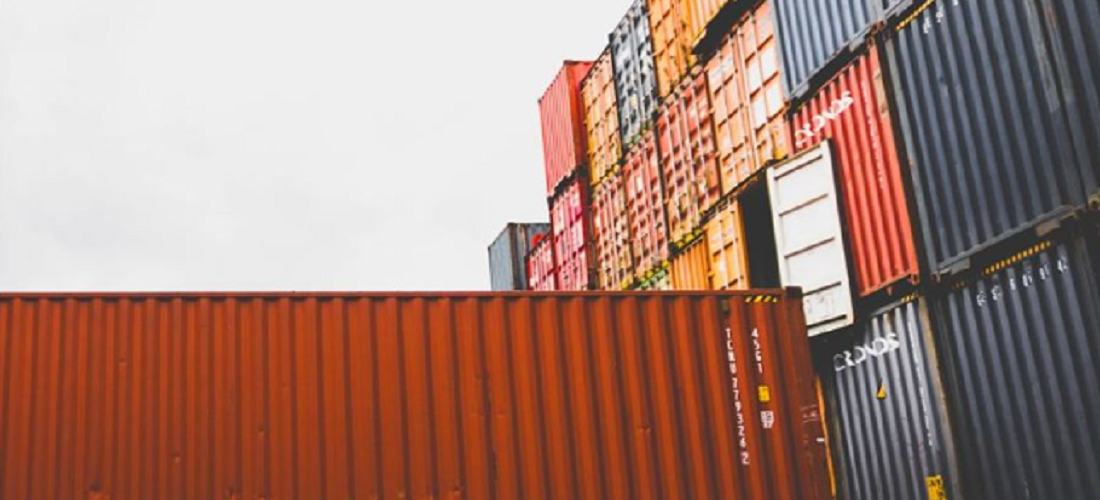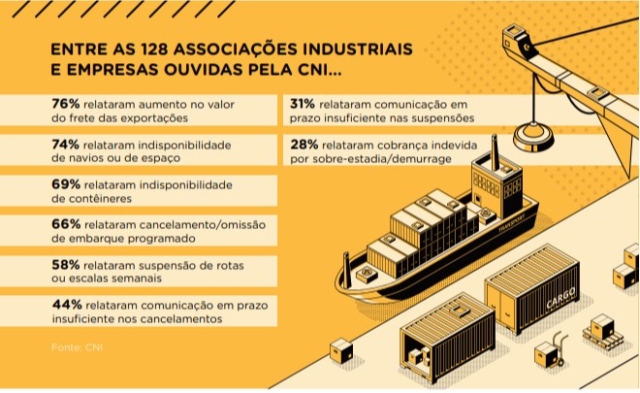
CNI explains impact on industry caused by 5-fold rise in container shipping
Dec, 22, 2021 Posted by Gabriel MalheirosWeek 202149
Despite being a cause for celebration, the resuming of economic activity after the severe lockdown of 2020-2021 also exposes problems that were dampened by the pandemic. One of the imbalances that are now out in the open is the explosive rise in container prices, which showed a fivefold increase vis-a-vis the previous year. Combined with the geographic and commercial characteristics of Brazil, this scenario has dramatically impacted exporters.
Brazil, due to its location, accounts for only 1% of the global containerized trade. The main international routes – cheaper and busier – can be found in the northern hemisphere. In addition, Brazilian trade balance features, which exports more commodities than manufactured products, further unbalance the accounts. “In the case of commodities, ships can still dock and fill, without the need for containers. As for manufactured products, it is only worthwhile for the vessel to come if it can be loaded with enough cargo to pay for the round trip. Otherwise, the operation becomes unfeasible”, says the president of the Brazilian Foreign Trade Association (AEB), José Augusto de Castro.
As a result, container prices, which ranged from US$ 1,800 to US$ 2000 per unit before the pandemic, have risen to the range of US$ 10000 and US$ 12000. Recently, the “Conderação Nacional da Indústira” (CNI), the most relevant industry association in the country, consulted 128 companies and industry associations. More than 70% of respondents suffered from either lack of containers or lack of vessels and more than half of them were forced to cancel or suspend activities. The survey also indicated that 96% of companies noticed an increase in the value of import freight and 76% of respondents noticed it in relation to exports.
Engineer, economist, consultant and logistics specialist Frederico Bussinger considers the term “container crisis” to be unprecise as he believes it is a symptom of a greater rearrangement process of global production chains. “Global production cycles were very much based on just-in-time operations. That is, the world was not used to stocking and products went straight to consumers. This has changed and the need for storage has become greater. There will be a natural reorganization of the process”, says Frederico.
He points out another issue that makes the scenario in Brazil particularly challenging. “The country does not have national large shipowners. This, in addition to our export portfolio’s characteristics and our need to import manufactured products, such as electronics makes our operation expensive.”
China has become the epicenter of the supply and demand global imbalance, causing backlogs of products in ports, empty containers shortages, and huge queues of ships waiting for berthing spaces.
Brazil is also likely to be impacted as European and American stocks will need to be replenished by the end of the year, which will further increase container prices. In addition, the global trade balance is being impacted by the massive increase in e-commerce, a reality that has boosted sales, leveraged commerce during the Covid-19 pandemic.
The director of the National Waterway Transportation Agency (Antaq), Flávia Takafashi, agrees that the absence of containers is linked to the increased pace in commercial operations, and not to a lack of the product itself. Agency data show that there was, in September 2021, an average increase of 15% in container handling in Brazilian ports vis-a-vis the same month in 2020.
Representative of another important player, the president of the Brazilian Association of Port Terminals (ABTP), Jesualdo Silva, recalls that the repressed demand stems from the fact that, during the pandemic, people were forced to save. He cites, for example, a study by financial consultancy Moodys that estimated that people around the world managed to save more than $5.4 trillion throughout 2020 when lockdowns and social isolation were more severe.
With the services industry at a standstill, the focus shifted to the digital acquisition of items, causing a surge in demand that surprised importers, logistics service providers, and factories around the world. “There are estimates indicating that this peak in extra demand translated into the need to handle more than 119 million containers between January and August, which was 6% more than the same period in 2019. Per year, 775 million containers are handled,” stated Jesualdo.
The president of ABTP highlights, however, the resilience of Brazilian ports. Based on data from the Ministry of Economy, Jesualdo points out that, until the third week of November, exports totaled US$ 249.5 billion, compared to US$ 190.7 billion last year – an increase of 35.5%.
-
Meat
Feb, 14, 2024
0
Brazil-Egypt ‘Pre-Listing’ Protocol Bolsters Meat Trade Ties
-
Ports and Terminals
Jan, 19, 2024
0
Brazil’s TCP Container Throughput Moves Past 1.2 Million TEUs in 2023
-
Ores
Jun, 19, 2019
0
Vale plans to build new railroad and port in Pará
-
Jan, 11, 2024
0
Paraguayan Pork Exports Experience Exponential Growth Following Taiwan Market Opening



